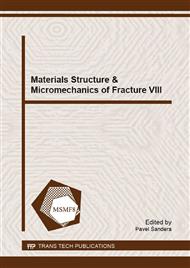[1]
J.L. Provis, J.S. van Deventer (editors). Alkali activated materials: state-of-the-art report, RILEM TC 224-AAM. Dordrecht: Springer, 2014. ISBN 978-94-007-7671-5.
DOI: 10.1007/978-94-007-7672-2
Google Scholar
[2]
C. Shi, P.V. Krivenko and D. Roy. Alkali-activated cements and concretes. London: Taylor & Francis, 2006. ISBN 04-157-0004-3.
DOI: 10.4324/9780203390672
Google Scholar
[3]
F. Puertas, M. Palacios, H. Manzano, J.S. Dolado, A. Rico and J. Rodríguez. J. Eur. Ceram. Soc. Vol. 31 (2011), p.2043-(2056).
Google Scholar
[4]
A. Férnandez-Jiménez, A. Palomo and D. Revuelta, in: 11th International Conference on Non-conventional Materials and Technologies, NOCMAT 2009, Conference proceedings. University of Bath, UK.
Google Scholar
[5]
N. Marjanović, M. Komljenović, Z. Baščarević, V. Nikolić and R. Petrović. Ceram. Int. Vol. 41 (2015), pp.1421-1435.
Google Scholar
[6]
M. Palacios and F. Puertas. ACI Mater. J. Vol. 108 (2011), pp.73-78.
Google Scholar
[7]
M. Chi and R. Huang. Constr. Build. Mater. Vol. 40 (2013), pp.291-298.
Google Scholar
[8]
S. Aydin. Constr. Build. Mater. Vol. 43 (2013), pp.131-138.
Google Scholar
[9]
A. Buchwald and M. Schultz. Cem. Concr. Res. Vol 35 (2005), pp.968-973.
Google Scholar
[10]
R. Kunal, R. Siddique and A. Rajor. Resour. Conserv. Recycl. Vol. 61 (2012), pp.59-68.
Google Scholar
[11]
P. Chaunsali and S. Peethamparan. ACI Mater. J. Vol. 110 (2013), pp.297-304.
Google Scholar
[12]
M. Konsta-Gdoutos and S.P. Shah. Cem. Concr. Res. Vol. 33 (2003), pp.1269-1276.
Google Scholar
[13]
B. L. Karihaloo. Fracture Mechanics and Structural Concrete, Longman Scientific & Technical, New York, (1995).
Google Scholar
[14]
RILEM TC-50 FMC Recommendation. Determination of the fracture energy of mortar and concrete by means of three-point bend test on notched beams. Materials & Structures (1985), Vol. 18, 285–290.
DOI: 10.1007/bf02472918
Google Scholar
[15]
V. Veselý and P. Frantík. Adv. Eng. Software, Vol. 72 (2014) p.66–76.
Google Scholar
[16]
P. Frantík and J. Mašek. GTDiPS software, http: /gtdips. kitnarf. cz/, (2015).
Google Scholar


